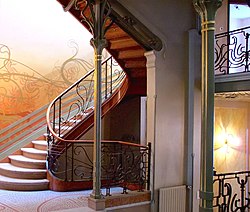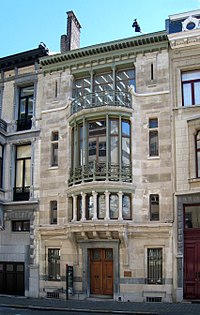Art Nouveau buildings by Victor Horta in Brussels
| Art Nouveau buildings by Victor Horta in Brussels | |
|---|---|
|
UNESCO world heritage |
|

|
|
| Staircase in the Hôtel Tassel |
|
| National territory: |
|
| Type: | Culture |
| Criteria : | (i), (ii), (iv) |
| Reference No .: | 1005 |
| UNESCO region : | Europe and North America |
| History of enrollment | |
| Enrollment: | 2000 (session 24) |
Art Nouveau by Victor Horta in Brussels is one of the UNESCO -listed site of World Heritage in Belgium . The cultural heritage includes four major Brussels town houses of the architect Victor Horta , to the bemerkenswertesten pioneering works of architecture of the Art Nouveau , the Art Nouveau in Belgium, include.
background
At the end of the 19th century, Victor Horta was one of the early pioneers of the stylistic revolution of the Art Nouveau, which is characterized by open floor plans, the light guidance through the building and the brilliant connection of curved decorative lines with the supporting structures of the building. Steel and glass, new building materials at the time, were used. Through the rational use of metal structures, partly openly visible, partly hidden in a sophisticated way, Horta created living areas flooded with light and air, directly adapted to the personality and needs of its residents. Modern supply and disposal facilities offered a high level of comfort.
The four World Heritage buildings pick up on the traditions of upper-class townhouses and stately private villas and combine residential and representative functions that require a clever organization of the various areas of use and their development . By Horta related to building type of Zweispänners , the two parts over a glass-covered, as conservatory usable traffic area are connected to each other.
The interior fittings are characterized by a surprising wealth of ideas, with decorative motifs that seamlessly transition from the mosaic floors to the murals and are also taken up by decorative elements made of wrought iron and custom-made furniture. Because Horta paid attention to even the smallest details, such as individual small pieces of furniture or the design of doorknobs and bells , he achieved a coherent overall impression of the structure and furnishings.
enrollment
At its 24th meeting, the World Heritage Committee decided to include the Art Nouveau buildings by Victor Horta in Brussels on the World Heritage List. Enrollment was based on criteria (i), (ii) and (iv):
(i): Victor Horta's townhouses in Brussels are the works of human, creative geniuses, which to the highest degree illustrate the influence of Art Nouveau on art and architecture.
(ii): The emergence of Art Nouveau in the last years of the 19th century was a decisive step in the development of architecture, which enabled a development based on it; Victor Horta's townhouses in Brussels are an exceptional testament to the radically new approach to Art Nouveau.
(iv): Victor Horta's townhouses are outstanding examples of Art Nouveau architecture, which particularly clearly illustrate the transition from the 19th to the 20th centuries in art, thought and society.
At the meeting it was also explained that the protection of townhouses is given special consideration in urban planning and that the buffer zones that have already been designated go beyond the requirements of the World Heritage Committee.
|
Ref.No. 1005- |
image | Surname |
Address (location) |
Remarks |
|---|---|---|---|---|
| 001 |

|
Hotel Tassel | Rue Paul Emile Janson 6 ( location ) |
The "Hôtel Tassel" can be seen as the founding building of Art Nouveau. Commissioned by Professor Emile Tassel in 1893, it is the first work in which Horta was able to implement his overall architectural concept with all the characteristic features that he had developed when building his other townhouses. The building was completed in 1894, but in the following years Horta continued to design pieces of furniture for the furnishings and to implement small changes requested by his client. Upon completion, the “Hôtel Tassel” generated mixed reactions, but was soon recognized as a key building in the development of modern architecture. |
| 002 |

|
Hotel Solvay | Avenue Louise 224 ( location ) |
Commissioned by Armand Solvay, the "Hôtel Solvay" was built from 1895 to 1898, and by 1903 the furnishings were completed. From 1899 additions were built according to designs by the architects Constant Bosmans and Henri Vandeveld, with Horta probably being consulted on their design. The “Hôtel Solvay” is the best preserved town house in Horta, the interior of which has been completely preserved, including the works of art, the original furnishings and the functional bathrooms and toilets. |
| 003 |

|
Hotel van Eetvelde | Avenue Palmerston 2–4 ( location ) |
Commissioned by the van Eetvelde couple in 1895, construction work began in 1897 on the “Hôtel van Eetvelde”. The west wing was completed in 1900, the east wing in 1901. The client Edmond van Eetvelda was a diplomat and general secretary of the Belgian Congo . The Hôtel van Eetvelde was to serve as a family home and representative building for receiving international guests. |
| 004 |

|
Maison & Atelier Horta | Rue Américaine 23-25 ( location ) |
The “Maison & Atelier Horta”, Victor Horta's home and studio , met the professional and family needs of the architect and was built from 1898 to 1901 in the elegant Brussels municipality of Saint-Gilles / Sint-Gillis . Although of modest size, the double building is a prime example of Horta's creativity. The property now houses the Horta Museum . |
The notable Horta Art Nouveau buildings in Brussels that still exist and are not a UNESCO World Heritage Site include the Hôtel Frison from 1894, the Hôtel Max Hallet from 1902 and the Magasins Waucquez from 1908, a department store that now houses the Belgian Comic Strip Center .
Web links
- Major Town Houses of the Architect Victor Horta (Brussels) / Habitations majeures de l'architecte Victor Horta (Bruxelles) on the UNESCO World Heritage Center website ( English and French ).
- Horta Houses (Belgium). (PDF, 49 kB) Evaluation by ICOMOS. UNESCO World Heritage Center, September 2000, accessed June 18, 2017 .
- The Major Town Houses of the Architect Victor Horta (Brussels). (PDF, 157 MB) WHC Nomination Documentation. UNESCO World Heritage Center, accessed July 20, 2017 (mostly in French).
Individual evidence
- ↑ Original name: English Major Town Houses of the Architect Victor Horta (Brussels) , French Habitations majeures de l'architecte Victor Horta (Bruxelles) , German name according to the World Heritage List. In: www.unesco.de. German UNESCO Commission , accessed on July 19, 2017 .
- ↑ Major Town Houses of the Architect Victor Horta (Brussels). In: whc.unesco.org. UNESCO World Heritage Center, accessed July 19, 2017 .
- ^ The Major Town Houses of the Architect Victor Horta (Brussels) (Belgium). Decision: CONF 204 XC1. UNESCO World Heritage Center, November 30, 2000, accessed July 19, 2017 .
- ^ Horta Museum. The museum's website, accessed on July 22, 2017 (English).
